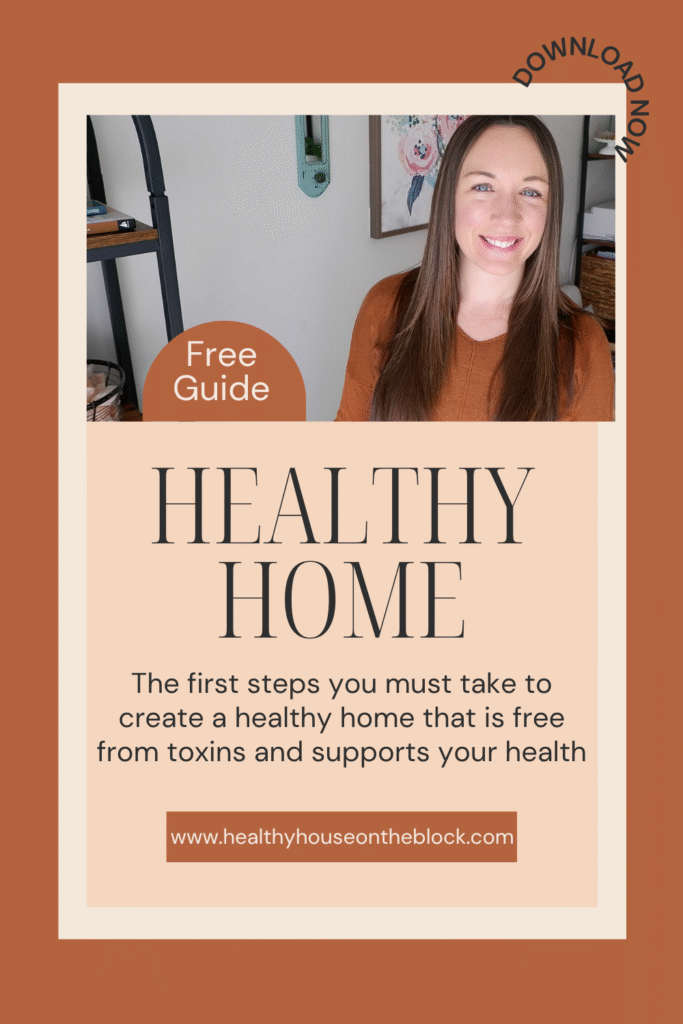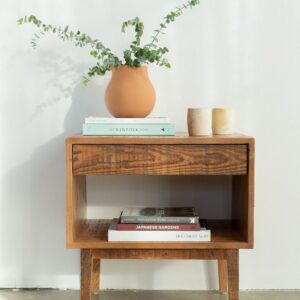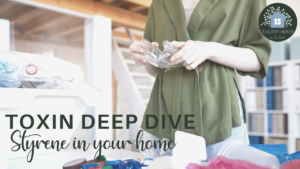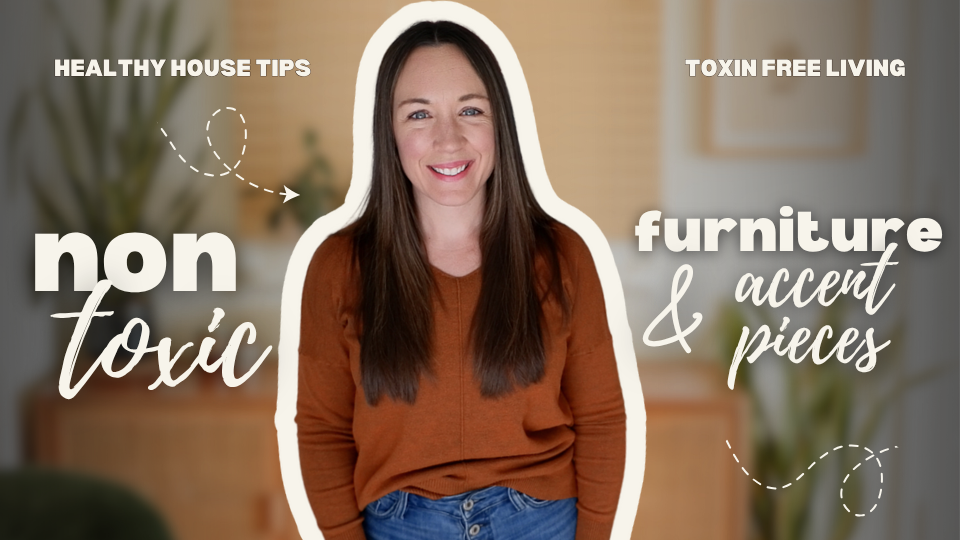
One of the most frequent questions I receive at Healthy House on the Block is about furniture—specifically, non-toxic furniture. The term itself can feel vague or overused, and the reality is, there’s a spectrum of healthier options. Depending on your family’s needs, budget, and goals, your “non-toxic” might mean completely natural, or it might simply mean significantly reduced toxins. Either way, you’re still taking a positive step.
As someone deeply committed to reducing toxins in my own home, I’ll be the first to admit: perfection isn’t always realistic. What matters most is doing the best you can, where you can. If you’re choosing low-toxin over conventional, you’re moving in the right direction.
This post focuses on non-toxic wooden accent furniture—think side tables, bookshelves, dining chairs, or benches. If you’re on the hunt for safer upholstered options like sofas or armchairs, check out this post on non-toxic couches.
Let’s break down the common toxins found in furniture, the healthier materials to look for, and where you can find non-toxic or custom-made wooden pieces.
(If you’re wanting to find a non-toxic couch, then check out this post.)
Hidden Toxins in Conventional Furniture
Formaldehyde: I recently wrote about this toxin in great detail and the health effects that this horrible toxin can cause. Formaldehyde is used in many applications of plywood and manufactured woods. Even if a piece of furniture appears to be solid wood, it could very well have parts of the furniture that are NOT solid wood. In addition, many adhesives that are used in furniture making contain harsh solvents, including formaldehyde.
The health effects of formaldehyde are harsh and have serious repercussions. Not only is it a known carcinogen, meaning it increases the risk of cancer, but it also causes toxicity to the reproductive system and issues in neurodevelopment of the brain and deterioration of the pulmonary system. (STUDY)
Benzene: Benzene is a volatile organic compound that is highly flammable and is often found in paints and adhesives that can be found in furniture pieces. Benzene off-gasses into the indoor air at rates based on the climate conditions indoors. As I’ve talked about before, the higher the humidity and temperature inside, the more off gassing occurs.
Benzene studies are often reported using high concentrations, but there are also health effects due to chronic low exposures in the home. Exposure to benzene has been reported to disrupt natural cell production, decrease white blood cell counts and cause changes to bone marrow activity. (STUDY). Benzene has also been found to be carcinogenic and has been linked to leukemia in several studies. (STUDY)
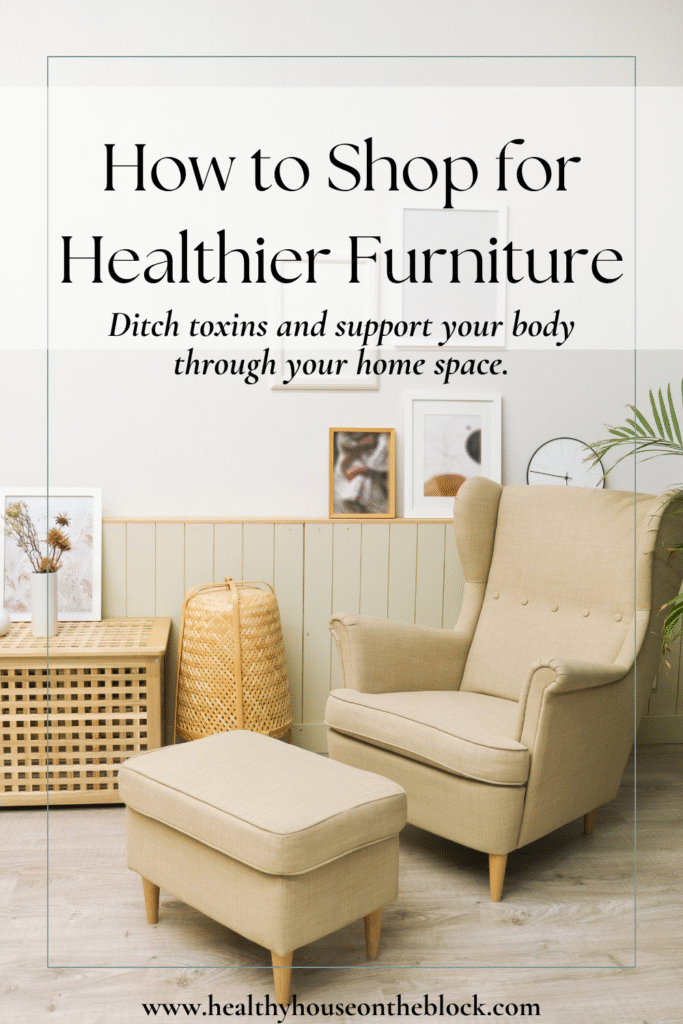
Vinyl Acetate: Vinyl Acetate is another chemical toxin found in glues and adhesives used in furniture manufacturing. Do you see a trend here? It’s oftentimes in the glue that holds the construction together. It can also be found in paints used on furniture in the home. Vinyl Acetate is one of the oldest chemical toxins being produced, dating back to 1912. This toxin off-gasses into the air and can get trapped inside causing high levels of concentrations.
Vinyl Acetate has been confirmed as an animal carcinogen and is classified as a possible carcinogen to humans. The health effects of vinyl acetate tend to target the respiratory system of the body as it is quite irritating. (STUDY). Another long term study linked vinyl acetate to cardiovascular deterioration as well as negative effects of the neurological system. (STUDY)
Phthalates: Another toxin deep dive I did recently on phthalates outlines in depth the health effects of phthalates and just how prevalent they are in our homes. While phthalates are found in many different spots throughout our home, in furniture they are found in components containing plastic. Think kids furniture or dorm room furniture that contains plastic parts and pieces as the main material in the furniture.
Phthalates contribute to a wide variety of health effects, especially in children. Phthalate exposure has been linked to abnormal reproductive development as well as neurological toxicity in both kids and adults. (STUDY). They also contribute to disruption of the endocrine system and alter natural production of hormones. This in turn causes issues with the thyroid and immune system as well as the reproductive process. (STUDY)
Isocyanates: This chemical is found in polyurethane that makes up the top coat of furniture that protects it from scratches and gauges. It is a petrochemical that is in MOST polyurethane protectants.
An adverse effect of this toxin is it causes asthma in both adults and kids. It also increases the risk for potential skin issues when it comes in contact with the skin. The International Agency for Research on Cancer has classified it as a possible human carcinogen.
Healthier Materials in Wooden Furniture
While the use of chemicals and toxins are prevalent in the furniture world, especially when it comes to painting and finishing wood inexpensively, you can find non-toxic furniture if you hunt for it. But you also need to know WHAT to look for and what materials and components are used in order to fulfill the promise of truly non-toxic furniture.
Natural Hardwood: Hardwood is a better option than softwoods as hardwoods tend to give off fewer VOCs than softwoods. You might wonder why this matters if there are no added VOCs in the furniture. VOCs are also found naturally in our environment outdoors, and so even plain wood can give off VOCs indoors and those VOCs can get trapped in the interior air. Opt for Maple, Oak, Walnut, Birch, Cherry or Ash when looking for natural hardwood.
Natural Finishes: Finishes on non-toxic furniture wood could be truly 100% natural finishes, or it could also be in the form of paints or stains. Raw linseed oil is a great option for a natural finish that is toxin free (be careful with this – boiled linseed oil is considered to be toxic). You can also look for furniture that uses natural beeswax as a finish. Walnut Oil and tung oil are other great options when it comes to natural finishes for non-toxic furniture. They also give wood a beautiful appearance.
Food Grade Polyurethane: Non-toxic furniture that has a clear coat of polyurethane either over the natural wood, stained wood or painted wood should be a food grade polyurethane. The second best thing is a plant based non-toxic wood sealer. Anything that is zero VOC when it comes to polyurethane is a great option, but food grade is the best as it is more closely regulated.
Non-Toxic Paint: If the non-toxic furniture you’re hunting for is a painted piece to add to your home, then you’ll want to make sure that it is third party certified. It’s likely that you won’t be able to find the brand of paint that the manufacturer used, in which case you’ll want to make sure that you know the paint has been tested and certified.
GreenGuard Gold is the best one to look for as it means the item will not degrade your interior air. You can also look for the SCS Global Services Certification. This certification addresses sustainability as well as toxicity of a product. Finally, a new certification you can be on the lookout for when shopping for non-toxic furniture is Intertek. It measures chemicals, flammability, safety and sustainability. It also tests for VOC emissions to ensure health and safety of a piece of furniture.
Adhesive Free: Adhesives often contain added formaldehyde as well as other solvents that make up the product. These toxins are considered VOCs and can off gas for the entire time the furniture is in your house. Finding furniture that is constructed WITHOUT adhesives is ideal. However, there are safe adhesives that contain zero VOCs and have no added formaldehyde that are a great option if furniture must be glued together in some fashion. This post talks all about adhesives and glues that are safe if you’re going to be adding some to your own furniture at home.
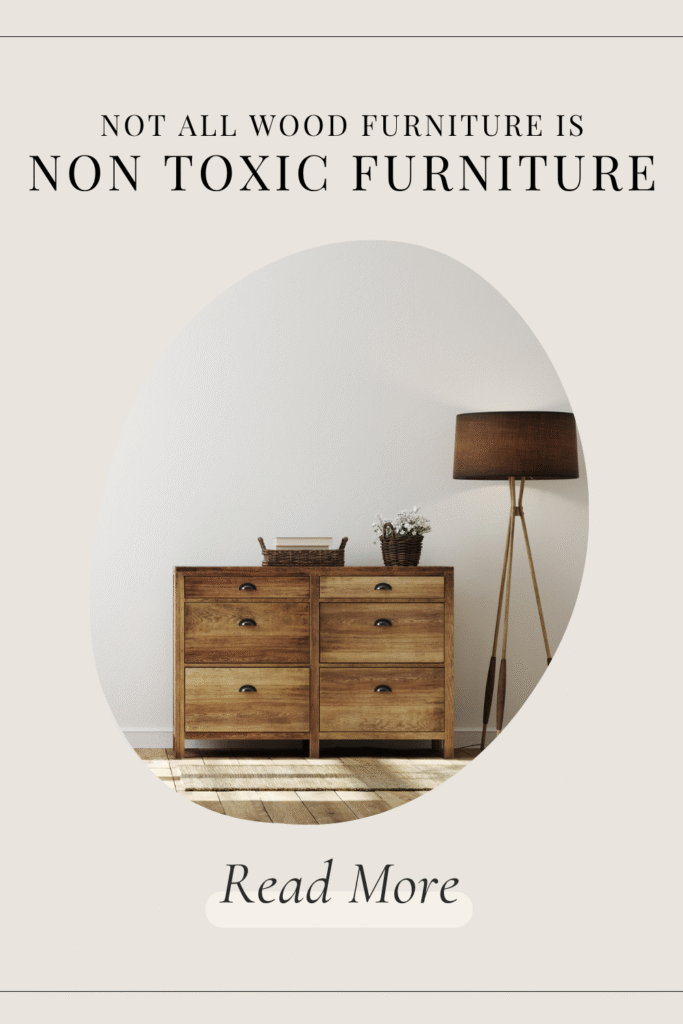
A Better Path: Handcrafted & Custom Wooden Furniture
Let me preface this with the fact that I hunted for non-toxic furniture to fit a very specific space in my house for SIX years. SIX. When I couldn’t find what I wanted in terms of natural wood, size and price point, I visited a local furniture craftsman and had our pieces handmade. I will tell you this was the BEST decision I have ever made when it comes to furniture, including finding non-toxic furniture. Was it more expensive? Yes. Did I have to wait for a long time for them to finish the furniture? Yes. But truly, it was worth it.
I would encourage you to look for local carpenters that make their own furniture. Oftentimes you can ask them to use non-toxic furniture finishes and they will gladly do this for you. If they won’t use a finish that you request, you can always ask them to leave it unfinished and finish it yourself with your own product.
If you’re hunting for non-toxic furniture locally and you want to go with hand made, I would recommend using terms like “local handmade furniture” or “custom furniture” or “hand crafted” with your city or areas behind it.
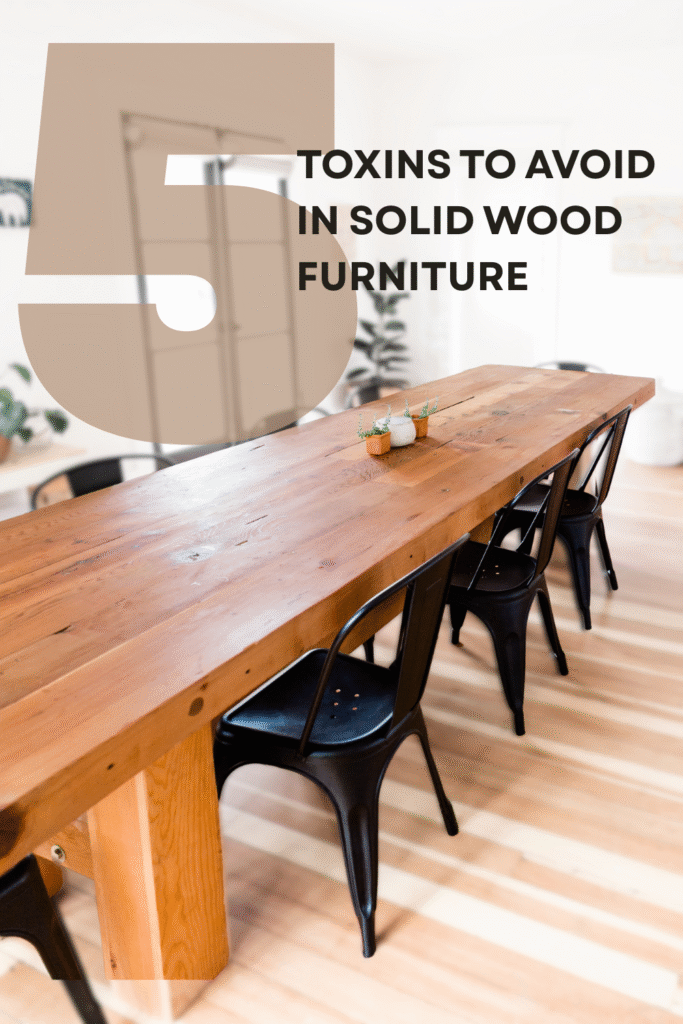
MY TOP PICKS WHEN YOU’RE NOT SHOPPING LOCALLY HANDMADE
Medley Home Furniture
Voya Coffee Table

Home Depot Unfinished Furniture
Hampton X-Sided Hardwood Sofa Table (Unfinished)
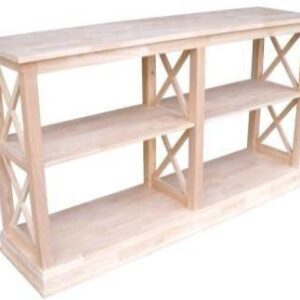
Etsy Handmade Furniture
Etsy Zero VOC Bookcase with Reclaimed Wood
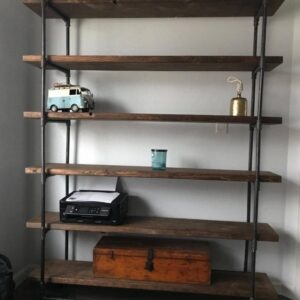
T.Y. Fine Furniture
Cantilever Side Table Solid Wood
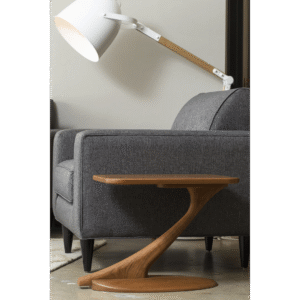
Avocado Mattress & Furniture
Natural Wood End Table
Green Cradle
Sea Green Bookcase Red Oak with Oil Finish

Vermont Woods
Glide Planes Walnut Round Glass Top Coffee Table
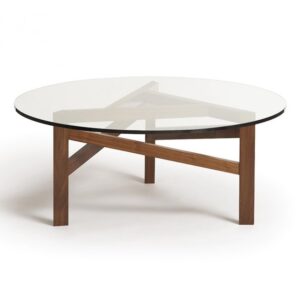
Romina Furniture
Uptown Single Dresser

Creating a healthy home isn’t about chasing perfection. It’s about reducing the overall toxic load wherever possible. With furniture, even choosing a solid wood piece over composite is a big step forward.
Keep learning, keep asking questions, and keep making the best decisions for your family. Whether you’re ready to invest in a custom piece or you’re just trying to avoid the worst offenders—your efforts matter.
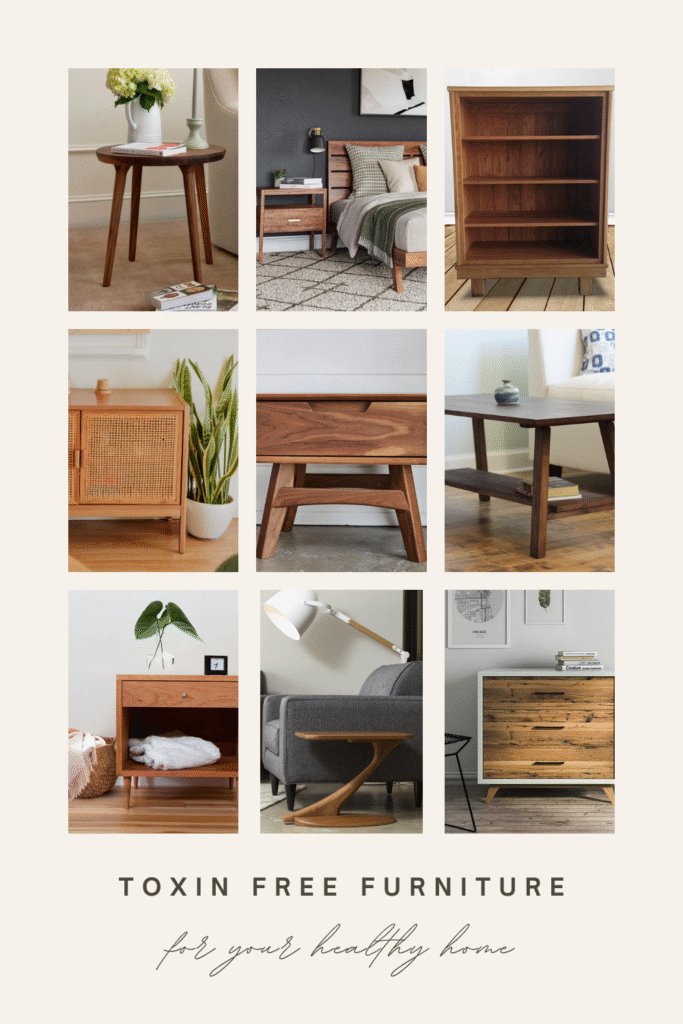
Share this:
- Click to share on Facebook (Opens in new window) Facebook
- Click to share on LinkedIn (Opens in new window) LinkedIn
- Click to share on Reddit (Opens in new window) Reddit
- Click to share on Pinterest (Opens in new window) Pinterest
- Click to print (Opens in new window) Print
- Click to share on X (Opens in new window) X

